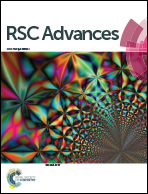Antileishmanial activity of sp2-iminosugar derivatives†
Abstract
A series of sp2-iminosugar-type glycomimetics bearing S-linked pseudoglycoside substituents (sulfide, sulfoxide and sulfone derivatives) has been synthesized and evaluated as new potential drugs against the protozoan parasite Leishmania, responsible of leishmaniasis, the second most relevant parasitic disease after malaria. All the prepared compounds share a bicyclic 5N,6O-oxomethylidenenojirimycin glycone-like moiety bearing a substitution pattern of configurational complementarity with the natural α-glucosides and incorporate either an n-octyl or n-dodecyl aglycone-like substituent. Not surprisingly, they behaved as potent to moderate competitive inhibitors of α-glucosidase (inhibition constants, Ki, in the range 1.3 to 447 μM). Evaluation of the antileishmanial activity indicated that the dodecyl pseudoglycosides present a significant antiparasitic activity in intracellular amastigotes of Leishmania donovani, the clinically relevant form of the parasite. The antileishmanial effect seems to be associated with the anticancer and proapoptotic activity of the glycomimetics, but not with the α-glucosidase inhibitory efficiency. The (SS)-configured dodecylsulfoxide derivative 4, exhibiting the most favourable activity/toxicity profile, was further assayed in combination treatment with miltefosine, the first oral antileishmanial drug, using the fixed ratio isobologram method. The interaction between derivative 4 and 0.1, 0.2 and 0.3 μM miltefosine was classified as synergistic, showing combination indices of 0.78, 0.76 and 0.80, respectively. Additionally, a miltefosine resistant Leishmania line and the wild-type strain showed similar susceptibility to derivative 4. The results illustrate the potential of sp2-iminosugar pseudoglycosides as promising prototypes for the development of new therapeutic strategies for leishmaniasis.


 Please wait while we load your content...
Please wait while we load your content...